
Fragrance in Colour
Book Specification
| Item Code: | IDD687 |
| Author: | Dr. Daljeet, Dr. V. K. Mathur and Rajeshwari Shah |
| Publisher: | National Museum, New Delhi |
| Language: | English |
| Edition: | 2003 |
| ISBN: | 8185832220 |
| Pages: | 120 (Color Illus: 53, B & W Illus: 232) |
| Cover: | Paperback |
| Other Details | 11" X 8.5" |
| Weight | 500 gm |
Book Description
Indian Miniature Painting has a long history of over thousand years and presents a comprehensive record of the religious and emotional feelings of the Indian people. These paintings show the Indian genius in its pure form. Its inspiration is rooted in the people's hearts, keeping close to their poetry, music and drama. The great merit of this art is the exquisite delicacy of drawing with decorative details. The artists of these miniatures used bright colours with tempara effect and display an unusual understanding of colour combinations.
National Museum began its collection of Paintings of Mughal, Malwa, Rajasthan, Pahari, Deccan and Central Indian styles from different sources from the year 1947. The National Museum has an extraordinary collection of more than 16, 000 paintings and undoubtedly, one of the most important collections in the world. It contains several examples which are of great interest from the artistic, historical and research point of view. Though the National Museum in the past had published several publications of merit, still there has been a strong demand that each Department of the National Museum should have a catalogue of the reserve collection and its related Gallery. In this direction the Department of Painting had set up the first modernized Gallery of Indian Miniature paintings and now the Department has prepared a complete catalogue cum handlist of all the objects displayed in the Gallery, the first of its kind.
Since I joined the National Museum as Director General in 1998, I have been emphasising the need of publication of publication of portfolios, gallery sheets and catalogues to popularize the museum objects to the masses and art lovers. This publication is an effort in this direction. I am happy that Dr. Daljeet, Dr. V.K. Mathur, Rajeshwari Shah have written this handlist cum catalogue keeping in mind the need of research scholars, students and general readers who have an interest in the realm of Indian Paintings. I am thankful to them. Now, other Curators off the various Departments will realise their responsibilities to publish such handlist/ catalogues urgently. Hope visitor will like the publication.
Indian miniature paintings on a small canvas, a few inches in length and width witness the aesthetic experience of India's great creative genius. With the introduction of paper in the 14th century, art activities gained a new impetus under the patronage of emperors and rulers of medieval India. These miniature paintings became silent spectators to the political, social, cultural and religious journey of India and thus provide us with important links to understand our unique past.
The gallery of Indian Miniature paintings in the National Museum, New Delhi is the first modernised gallery which comprises of 352 objects of which 262 are miniature paintings belonging to major art styles suchas Pala, Jain, Mughal, Deccan, Central India, Rajasthan, Pahari, Sikh, Kashmir, and Company. They date from the early 10th century to the early 20th century. Great caution was exercised while displaying objects in the gallery as it was felt that all aspects and mediums of miniature paintings must be included to provide the viewer, who visits the gallery a broader idea of the art activities in medieval India. For the first time, displayed objects include, besides paintings on paper, Pichhawais and Scrolls on cloth, maps, painted book covers and windows on wood, Buddhist Thankas and Jain patas on cloth and painting on leather. Beautiful calligraphy in Sanskrit, Perisian, and Devnagari on both palm leaf and paper which was combined by the artist skillfully, depicts our literary tradition with our artistic tradition. Objects used in medieval sports such as embroidered chaupar painted dice and playing counters, playing cards-Ganjifas, and painted ivory images have also been included with the aim of providing a total view of the art scenario prevailing in medieval India. All major themes from Indian miniature paintings such as Ramayana, Mahabharata, Bhagavata Purana, Gita Govinda, Rasa Manjari, Rasikapriya, Bihari Satsai, Rasaveli, Shahnama, Tutinama, Twarikh-i-Alfi, Ragamala , Baramasa, Nayika-Bhed and manyothers random these have been included providing something of new for all who visit the gallery.
We are thankful to Dr. R.D. Choudhury, Director General, National Museum, all our colleagues and staff members of the Museum for providing us full cooperation for setting up the New Gallery of Miniature Paintings. An enterprise of this magnitude could not have been undertaken without their support. With their help and encouragement we are now able to prepare this extensive catalogue-cum-hand list of all the exhibits displayed in the new modernized gallery.
Indian miniatures are in the art world a class by themselves. On a small canvas a few inches in length and width, these mute witnesses of the centuries' long journey of aesthetic experience of India's great creative genius translate the legends of ages, yearnings of love, emotions of pain and pleasure, sublimation of temporal aspirations and dimensions of tiny human efforts into their lines and colours.
The Origin and History of Painting
The art of painting, a branch of chitra, is acclaimed to have a divine origin and Lord Vishnu is its progenitor. It evolved as a spontaneous act. Lord Vishnu, fascinated by the ravishing beauty of Urvashi, unconsciously sketched her likeness on his thigh and created the first ever portrait. He taught chitra to Vishvakarma and wished that its knowledge was imparted to mankind. Chitra, with numerous connotations, is the theme of several Shilpa and Agamas Texts.
Anthropologically, the earliest examples of painting in India are seen in rock-shelters. The wandering nomad, after he settled in rock-shelter, sketched on rocks fierce wild animals, may be, to train himself better to hunt, or to get rid of fear psychosis. Bhim-Betaka, the earliest of which is estimated to date around 10.000 B.C.
Indus pottery defines another stage of painting in India. Earthen pots were now the painter's canvas. Well defined lines a strong sense of geometry and bright colours characterised this new style. Creepers and floral patterns, constituted the greater part of his theme.
The great epics, the Ramayana and the Mahabharata, discover many of their characters engaged in art activities. Rama's Ayodhya had in its palace a permanent chitra-vithi and Lakshmana regularly supervised it. In the Bhagavata Purana Chitralekha, the friend of Banasura's Daughter Usha, was a skilled painter. It was she who portrayed Aniruddha, the grandson of Lord Krishna, exactly as he was, though she had only heard of him from Usha who herself had seen him only in a dream.
India had from the 4th to the 7th century, her most glorious phase of the art of painting in the form of murals at Ajanta, Ellora, Bagh, several monasteries and temples. The Ajanta murals outstand them all and are amongst the most beautiful murals in the world. In these paintings there reflects a continually evolving art tradition gaining new heights day by day. In costumes and landscape, Bagh caves are not as elaborate as Ajanta but their depiction of nature is much more serene and calm. At Ellora, painting is subordinate to sculpture and cover mostly the ceilings and mandapa walls. Ellora has a strong sense of anatomy of man and animals and also of floral creepers.
Evolution of Miniature Paintings Miniature art form made its debut in the 10th century. Prajnaparamita, the Buddhist text illustrated on palm-leaf in 999 A.D. is so far the earliest known examples of miniature art form. Except for a few Kalpasutra folios rendered on both, palm leaf and cloth strips, hardly a few paintings for the period from the 10th to 14th century have come to light. The Kalpasutra tradition seems to have continued until the 16th century. It seems these votive paintings, easy to transport, gained the favour and patronage of travelling devotees. Such paintings were also rendered for Kalpasutra manuscript of 1439 A.D. was rendered for some Jain monk at Mandu.
In the 14th century, palm leaf was replaced by paper and to earlier colours were added new mineral colours and pigments. Paper, with its tougher, smoother and better pigments absorbing surface, almost revolutionized the entire art scenario. The Bhakti movement had enormously increased the demand for votive represntations. The painting production, thus, not only multiplied but had become a profit-oriented profession attracting artisans of other craft to move to it. Most artist, while competing with others, struggled for their own distinction. Rulers, craving to see themselves and their taste and likings reflected on canvas, began patronizing painters. This gave birth to various art styles and marked a shift from votive to secular art and from the patronage of traders to that of feudal lords. The major bulk of miniatures and their styles evolved obviously thereafter, that is, from the 15th to the 19th century.
The Essence of an Indian Miniature What defines an Indian miniature is difficult of underline, but it is much easier to feel its distinctiveness, its unique power to emotionally move, something which only and Indian miniature is endowed with. The directness of expression, a kind of transparency wherein lines, forms or colours conceal nothing behind them is its strength. The power to generate transcendental delight is the essence of an Indian miniature.
Nature has in Indian miniatures a significant role. It imparts to them their perspective and sometimes their theme. Despite a small canvas, they often expand so much that in them the worlds of man and nature meet and unite. Gorgeous border, fine line-work, perfect execution, balanced composition, unique colour scheme, scenic vividness, thematic thrust and ages of India's art tradition and creative aptitude are some of the attributes that characterise an Indian miniature.
Texts like Buddhist Jatakas, Jain Kalpasutra , Ramayana, Mahabharata, Bhagavata-Purana, Abhijnana-Shakuntalam, Rasa-Manjari, Gita-Govind, Sursagar, Rasikapriya, Bihari-Satsai and Janamsakhi, Perisian texts like Shahanama, Hamazanama and Tutinama, memories of Mughals like Baburnama, Akbaranama and Patshahnama, folks and legends like Baz Bahadur-Roopmati, Dhola-Maru, Laila-Majnun, Panchantantra and Nala-Damayanti, abstractions like Ragas, Baramasa and Tantra, emotions of love, pain and pleasure, festivals, history, court and village life are broadly the themes that an Indian miniature weaves around its lines and colours.
Calligraphy had great significance in miniature paintings from the days of Buddhist Jatakas to the medieval age. Portraiture constitutes a considerable bulk of Indian miniature. Akbar was the first ruler to encourage portraiture, but restricting it to representations of only royal personage and courtiers. Female portrayal was not popular. Jahangir, with portraits of Nurjahan, encouraged female portrayal. Dynasties' albums and portraits of patrons were largely rendered.
- Foreword
- Preface
- Introduction
- Mughal Miniatures
- Deccani Miniatures
- Central Indian Miniatures
- Rajasthani Miniatures
- Pahari Miniatures
- Colour Plates
- Handlist
- Bibliography
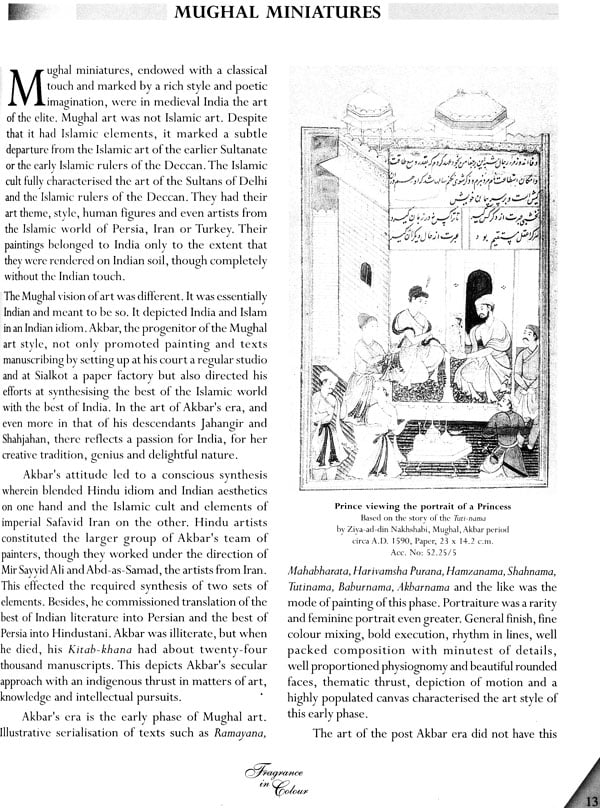
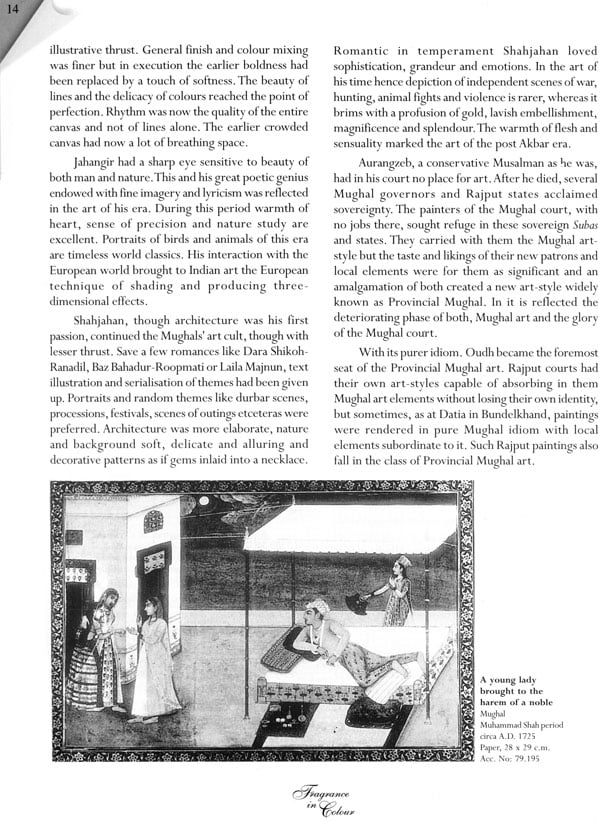
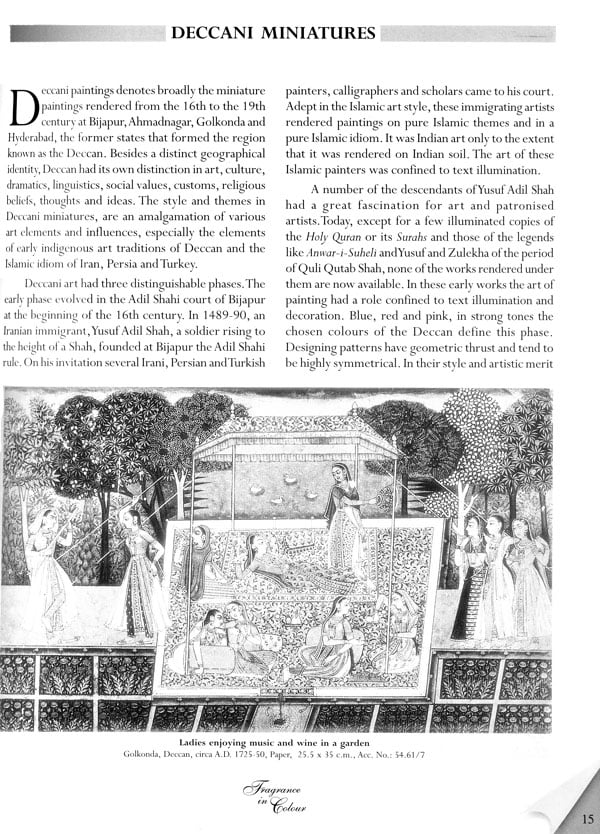
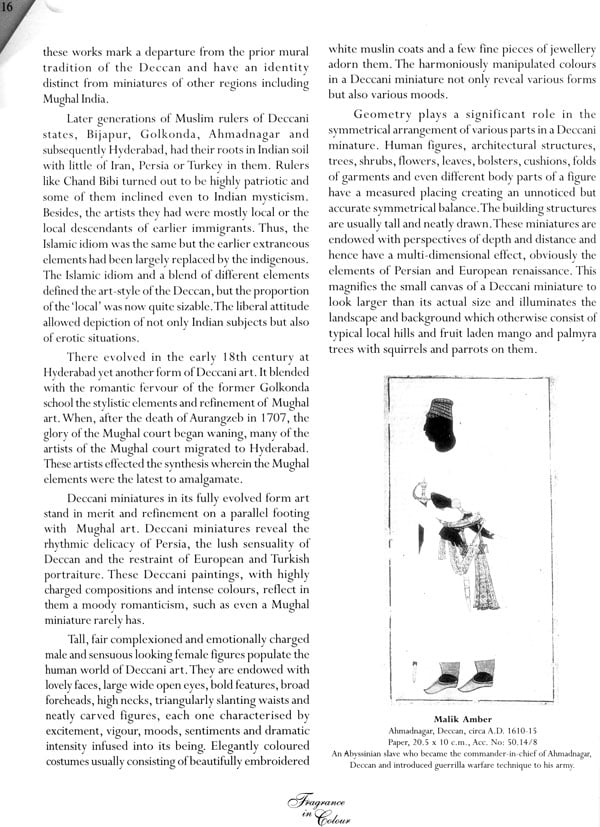
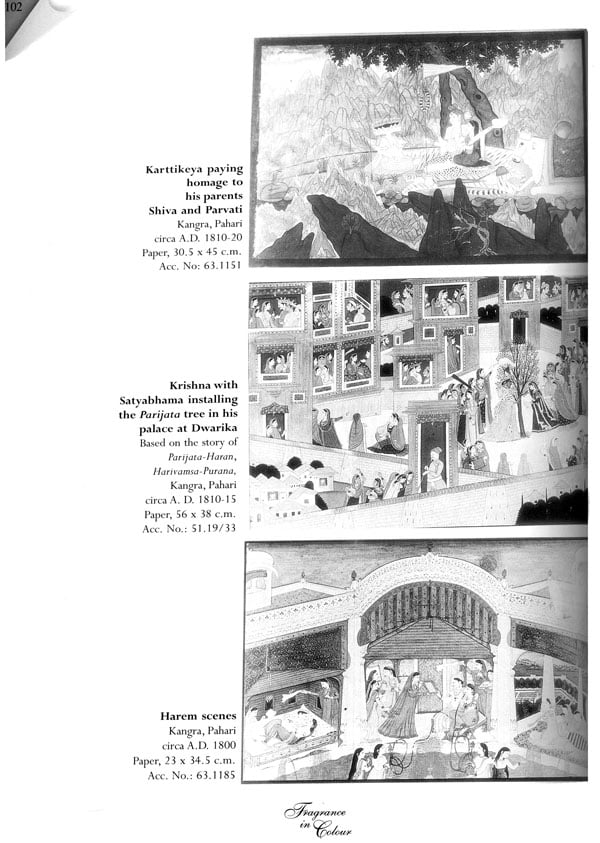
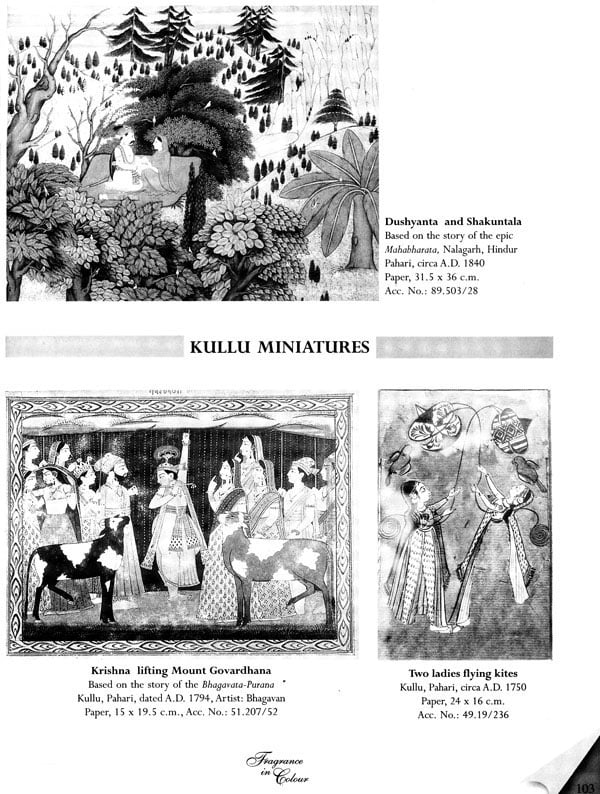
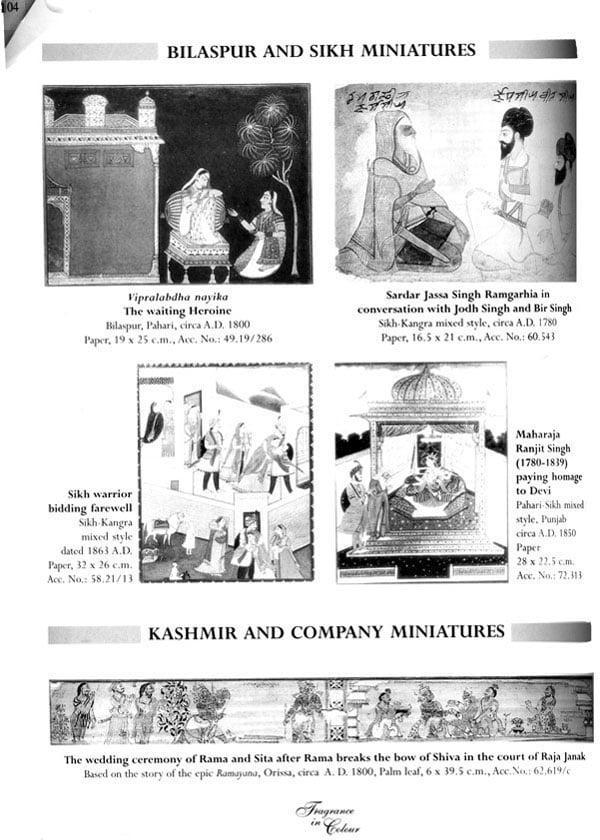
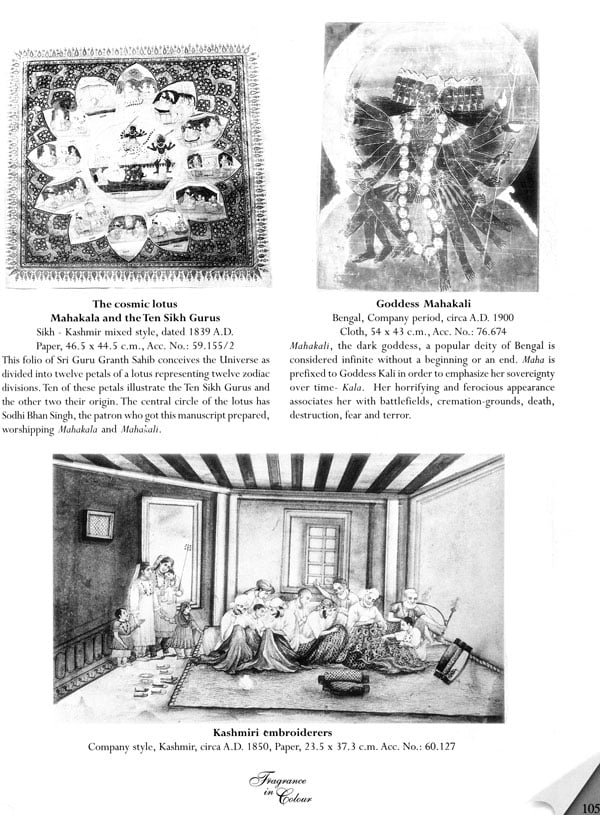
Click Here for More Books Published By National Museum





